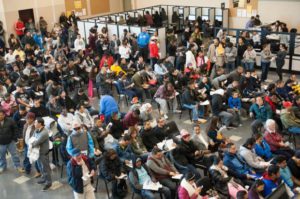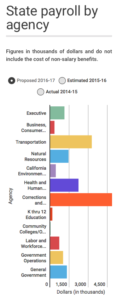AI and Automation to Claim Public Sector Jobs in the Future
There are over 340 California state agencies employing over 200,000 people full-time. Monthly, this equates to over $1.8B in gross wages (http://sco.ca.gov/ppsd_empinfo_demo.html). California, along with many other states in the country, constantly struggle to balance annual budgets while minimizing budget deficit. The obvious question arises of whether artificial intelligence and automation will claim public sector jobs as these technologies mature. Although the answer seems obvious given budget reasons, government is notorious for being slow to adapt and there are numerous other factors that must be taken into consideration. Ultimately, the fate of these employees will depend on Silicon Valley’s ability to convince key decision makers that technology adoption equates to cost savings.
Deloitte estimates that approximately 16% of public sector jobs will be claimed by automation by 2030 (http://www.businessinsider.com/automation-to-claim-850000-public-sector-jobs-by-2030-2016-10) . The jobs most at risk of being replaced are administrative and operative. As government processes become digitized and further streamlined, many “paper-pushing” jobs will naturally just disappear. A common pain point for Californians is how slow the Department of Motor Vehicles (DMV) can be for menial needs.

The DMV has been plagued by technical challenges, such as in 2013 when they suddenly canceled a critical registration software overhaul after it was halfway complete at a cost of $135M so far. Future integration of better software and further automation should help the CA DMV improve from it’s current position of 2nd slowest department of motor vehicles in the country. Ultimately, many public sectors roles that are repetitive and predictable will be phased out.
The agency with the largest state payroll is the California Department of Corrections and Rehabilitation (CDCR). (http://www.sacbee.com/news/politics-government/the-state-worker/article54481660.html) The CDCR employs approximately 24,000 state correctional officers and 1,800 parole officers. State correctional officer’s jobs could be reduced and become safer using computer vision surveillance and further segregation of inmates using smarter prison infrastructure. The average annual cost to house a single inmate is over $70,000. There are currently over 130,000 inmates in California, causing the CDCR to require an annual budget of $11B, approximately 9% of the states total budget (http://www.ebudget.ca.gov/2017-18/pdf/BudgetSummary/SummaryCharts.pdf). To put things into perspective, this state’s entire higher education system takes up 14% of the state budget. There are definitely improvements that can be made here to save taxpayer dollars while providing safer correctional facilities. AI and automation will play a large role in the evolution of this department and many others, however the key stakeholders and decision makers may not be in the best position to make difficult transformation a reality when it involves massive layoffs.
The CDCR employs approximately 24,000 state correctional officers and 1,800 parole officers. State correctional officer’s jobs could be reduced and become safer using computer vision surveillance and further segregation of inmates using smarter prison infrastructure. The average annual cost to house a single inmate is over $70,000. There are currently over 130,000 inmates in California, causing the CDCR to require an annual budget of $11B, approximately 9% of the states total budget (http://www.ebudget.ca.gov/2017-18/pdf/BudgetSummary/SummaryCharts.pdf). To put things into perspective, this state’s entire higher education system takes up 14% of the state budget. There are definitely improvements that can be made here to save taxpayer dollars while providing safer correctional facilities. AI and automation will play a large role in the evolution of this department and many others, however the key stakeholders and decision makers may not be in the best position to make difficult transformation a reality when it involves massive layoffs.
There is no doubt that a plethora of both public and private sector jobs will be replaced, but the uncertainty lies in how quickly this transition will occur. PWC estimates that 38% of ALL jobs in the US will be at risk of automation by around 2030 (http://www.latimes.com/business/la-fi-pwc-robotics-jobs-20170324-story.html), a much higher percentage than jobs at risk just in the public sector. Some of this discrepancy lies in the complexity of certain public jobs, such as police officers and teachers. Large swathes of low education jobs such as transportation, manufacturing, and retail will be immensely vulnerable to replacement. Advances in technology will inevitably transform the entire workforce and the general way of life for humanity…for better or for worse.
Users who have LIKED this post:
One comment on “AI and Automation to Claim Public Sector Jobs in the Future”
Comments are closed.


This is a topic that I have been unable to put aside since I read about titans of the tech industry considering the possibility of a “universal basic income”.
http://www.cnbc.com/2016/11/04/elon-musk-robots-will-take-your-jobs-government-will-have-to-pay-your-wage.html
Since then, headlines show this process of replacing humans with automation in a variety of roles has continued. While for much of history this process of automation has been prevalent and steadily increasing it seems that today the effects promise to be much more complete and widespread. Industry that employee staggering percentages of the U.S. and the world will likely soon create an unemployment problem that must be faced. A prime example of this includes automating the jobs of truckers (http://www.latimes.com/projects/la-fi-automated-trucks-labor-20160924/) and the possibly (further) devastating effects to retail by amazon with their new cashier free stores (https://www.theverge.com/2017/2/6/14527438/amazon-go-grocery-store-six-human-employees-automation). The intersection of the private sectors pursuit of efficiency and government in this area has already become turbulent in areas like minimum wage disputes (https://www.forbes.com/sites/realspin/2016/11/29/thanks-to-fight-for-15-minimum-wage-mcdonalds-unveils-job-replacing-self-service-kiosks-nationwide/#4d69bb294fbc).
As you said, I do find it likely that the public sector will lag behind. With the bottom line not being the only consideration the public sector has many hurdles including unions (https://www.forbes.com/sites/kaviguppta/2016/10/12/will-labor-unions-survive-in-the-era-of-automation/#31ae18f93b22) and the obvious security implications.
Examples become more prevalent by the day, while solutions seem to be much less accessible … I believe this is something that requires our serious attention before we find ourselves underwater.
Users who have LIKED this comment: